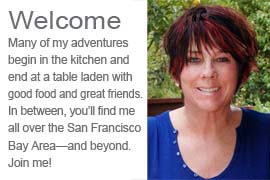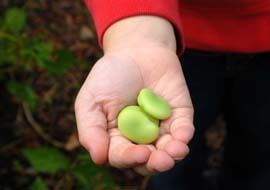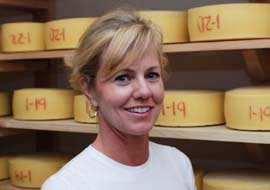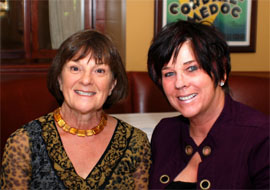As Good as Gold; A Visit with a Local Cheesemaker
Meet Karen Bianchi-Moreda, a talented artisan cheesemaker and owner of the Valley Ford Cheese Company. Karen is the creator of Estero Gold, one of the best cheeses that we’ve eaten at Beyond Wonderful in a very long time. This fourth-generation dairy farmer swears by the rich, raw milk of her prized, 100-year old Jersey herd. Combine that special milk with the passion, intelligence and inherent “cow sense” that run in Karen’s family—and you’re bound to get an extraordinary cheese like Estero Gold.
Recently, I met with Karen at her 640-acre, family-owned farm on the Marin-Sonoma border. After a tour of the farm, the cheesemaking facilities and the aging room, we sat down to talk.
![]() BA: Dairying goes back generations in your family, but you’ve only been making cheese for three years. What made you go into it?
BA: Dairying goes back generations in your family, but you’ve only been making cheese for three years. What made you go into it?
![]() KBM: I’d been thinking about it for a while but the timing was always wrong. Then one January day as I sat at the old round table in the sausage-making room with a few family members and friends, it just came out—“I want to make cheese.” I started with a mail-order kit.
KBM: I’d been thinking about it for a while but the timing was always wrong. Then one January day as I sat at the old round table in the sausage-making room with a few family members and friends, it just came out—“I want to make cheese.” I started with a mail-order kit.
BA: That’s quite a stretch from cheesemaking kit to producing a first-class product. How did you get so good?
KBM: During the first 10 months I read all the cheese science books and articles I could lay my hands on. In between, I made lots of cheese in 2-gallon batches; mixing and testing, brining and aging—never knowing what I was going to get until it finished aging.
BA: So is this a science you can learn from a book…or more of an art?
KBM: Both, really. Once I understood the science, I followed my instincts in perfecting what became Estero Gold. At one point, I asked a colleague who had judged cheeses at the state fair for an evaluation. He really liked the cheese and recommended that I keep it as is. But my instincts told me that it still needed something, so I tried a new culture and it worked.
BA: Tell me how your family’s heritage influences your approach today.
KBM: I’m fourth generation on the farm that my great-grandparents began in 1918. From birth we’re all part of a strong working family that loves the land and our animals… we’re always in-tune with the earth and its rhythms. Cow-sense is in our blood—it affects everything we do.
BA: So will your children join you in the business?
KBM: Yes! I’m so proud of them both; they are doing well at university and following their dreams. Joe wants to make cheese, and Jim is exploring ice cream. Just think of the possibilities with our beautiful Jersey milk!
BA: Deliciousness is so subjective…in your mind what qualities signify a truly great cheese?
KBM: I believe that a well-made cheese becomes great when eaten with good people in a beautiful setting. Think how you’d feel sitting on a hillside looking out at a breath-taking view of the Swiss Alps—or your favorite spot— eating cheese, some fruit and sipping wine. That’s delicious living and cheese at its best.
BA: What goes into creating a new cheese? Is it something you just whip up quickly? Share a little about the process of developing your Estero Gold.
KBM: I wanted to make a raw milk farmstead cheese built on the traditional methods of the Ticno area on the Swiss-Italian border, where both of my great-grandmothers were born. But my cheese would be unique using the rich Jersey milk of my beautiful girls and infused with my personal flair—a real California cheese.
BA: So you start with a clear vision; did you create a special “secret” recipe for Estero Gold?
KBM: (Laughs) I get asked that a lot—and, no there is no secret recipe. It’smore of a dynamic, always-changing one. Each batch is different, depending on the elements, what the cows are eating at the time of milking—more grass or feed. I test the milk regularly and adjust the “recipe” as I work.
BA: Tell me a little about the aging process.
KBM: I make Estero Gold in small lots, then form them into rounds that are brined for three days. I prefer the old-fashioned method of brining, which adds salt to the process without mixing it into the milk. I hand date each round and place them in my small, temperature-controlled aging room for six months. The cheese is pliable at four months, and more complex and nutty when finished.
BA: Do you get consistent results each time?
KBM: You never know what’ll you’ll get until the cheese has finished aging. So I cut open a round and test it before packaging.
BA: What’s your favorite way to enjoy Estero Gold?
KBM: Oh, that’s easy: good crackers topped with the cheese, sliced pears and a glass of wine. I also love it with thin slices of prosciutto and homemade sausages.
BA: Do you cook with it?
KBM: Of course! I shred and sprinkle it over salads, mix it into polenta and pasta dishes—and make a mean cheese-sausage stuffed Jalapeno popper. Basically, it’s good on just about anything that you use cheese in.
BA: OK..a little off the topic…but I had a strong sense of déjà vu when I drove up the farm’s driveway. Weird, huh?
KBM: (Laughing) Not weird. Did you ever see Alfred Hitchock’s movie, The Birds? My grandparents let him film several big scenes here at the farm in the early 1960s. We’ve modernized and done some building, but overall, things still look pretty much the same as they did then.
Read more about Karen Bianchi Moreda at the Valley Ford Cheese Company and in Mark “The Cheese Dude” Todd’s column, Feasts for the Fireside.










